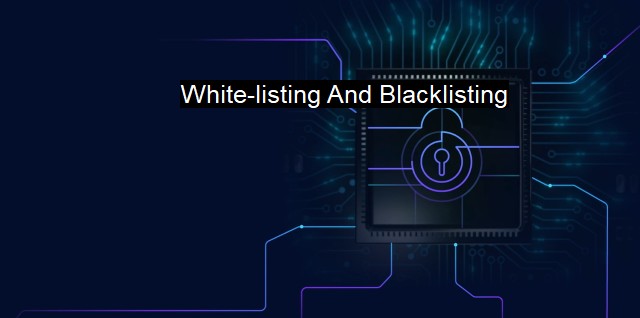What is White-listing And Blacklisting?
Enhancing Cybersecurity with White-Listing and Blacklisting Strategies: How Antivirus Software Decides What is Safe and Harmful
White-listing and blacklisting are both prominent cybersecurity strategies used in various ways, including securing email servers, enhancing firewalls, supplementing antiviruses, and maintaining software operations. These approaches are often implemented for controlling access to systems, deciding whether to allow or block data packets, emails, or applications from running in a computer system.White-listing is a security strategy that works by only allowing certain pre-approved entities to have access privileges and refusing all others. The whitelist comprises approved and verified items, such as email addresses, websites, applications, IP addresses, and more. When used in an antivirus situation, it can be much more effective than blacklisting. It inhibits unauthorized applications from executing or stopping potential threats before they become a problem. For instance, the system only allows the installation and execution of applications listed in its white-list, blocking all other apps, which considerably reduces the risk of malicious software infiltration.
Whitelisting is especially useful in high-security settings where only identified and trusted entities are permitted to interact or exchange data with the system. It is crucial in dealing with zero-day threats, i.e., new threats that have not been added in security databases. the extreme security measures can hold back functional flexibility as only previously coded programs or applications get the authority to access or interact. This puts a stringent call on frequent updates of the whitelist database, making it more labor-intensive.
On the other hand, blacklisting cybersecurity implementation works in polar opposition to white-listing. In a security standpoint, blacklisting holds a list of identified entities known to be sources or carriers of harm, preferring to allow all except those explicitly mentioned in the blacklist. Blacklisting will block all known threats such as identified malicious files, blackhat IP addresses, spam-associated domains, and harmful websites. In an antivirus context, blacklisting seeks to prevent these known threats from executing their malicious endeavors onto the network or system by preventing them from gaining access.
Fundamentally, while whitelisting is a practice of default denial – 'deny all, permit some', blacklisting is between default permission – 'permit all, deny some'. In other words, blacklists operate on ‘innocent until proven guilty’ assumption whereas whitelists operate on a ‘guilty until proven innocent’ basis.
Blacklisting is a practical strategy in a broad-based security environment since its policies permit a wide range of applications to operate. Despite its protection abilities against known security threats, it's prone to risk factors as any unidentified hazardous agent could be approved and permitted in the system. Thus, it’s not as effective as whitelisting in deterring potential threats.
Both whitelisting and blacklisting offer their unique benefits irrespective of their limitations. The decision of utilizing one technique over the other is dependent on the kind of infrastructure the security plan targets, their technical specifications, and there're aspects of environment variability, particularly, network and requirement complexity.
Whitelisting's restrictive process is challenging to maintain in a complex network and requires dedicated efforts to sustain, though it offers stellar security against zero-day threats. Meanwhile, blacklisting provides more flexibility, convenience, and reach but lacks thoroughness. Both techniques should ideally be used in systematic encryption, reinforcing the firewall capabilities, software restriction policies, and discrepancy-oriented security requirements.
A layered approach, using both methods, can support thorough proactive and reactive defense mechanisms capable of handling a range of known and unknown security threats. Whichever list is preferred in configuring security policies — or whether these two lists are used conjointly — refining and updating them should always be part of an organization's cybersecurity strategy for enabling optimized and effective defense.

White-listing And Blacklisting FAQs
What is white-listing in the context of cybersecurity?
White-listing is a cybersecurity technique that involves allowing only pre-approved and trusted applications or processes to run on a system. This helps to prevent malicious software or unauthorized applications from being executed on the system.What is blacklisting in the context of cybersecurity?
Blacklisting is a cybersecurity technique that involves denying access or blocking specific applications, files, or websites that are known to be malicious. This helps to prevent malware, viruses, or other threats from harming a system or network.What are the advantages of using white-listing over blacklisting?
White-listing provides better security because it only allows pre-approved and trusted applications to run, so there is a lower risk of malware or other threats being executed on the system. It is also more difficult for attackers to bypass white-listing than blacklisting.How can I implement white-listing and blacklisting on my computer or network?
You can implement white-listing and blacklisting by using antivirus software or other security tools that offer these features. You can configure the software to allow only approved applications to run or block specific websites, files, or processes. It is also important to keep your security software up-to-date to ensure maximum protection against emerging threats.| | A | | | B | | | C | | | D | | | E | | | F | | | G | | | H | | | I | | | J | | | K | | | L | | | M | |
| | N | | | O | | | P | | | Q | | | R | | | S | | | T | | | U | | | V | | | W | | | X | | | Y | | | Z | |
| | 1 | | | 2 | | | 3 | | | 4 | | | 7 | | | 8 | | |||||||